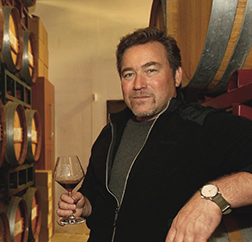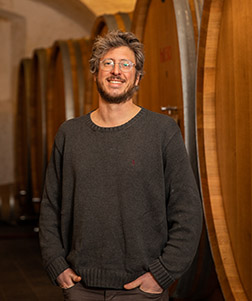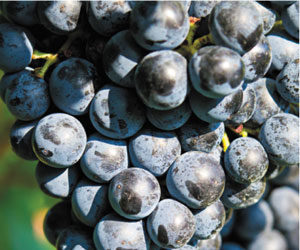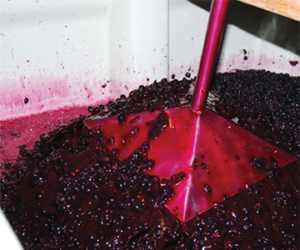
For many wine drinkers and winemakers, Pinot Grigio, or Pinot Gris if you prefer the French name, is a quaffing wine, light- to medium-bodied; a refreshing alternative to Chardonnay, yet unremarkable.
Full disclosure, I thought much the same until I met Steve Clifton. The winemaker from California’s Vega Vineyard & Farm is a Pinot Grigio evangelist. He’ll fully convert anyone into appreciating this massively underrated grape. If there’s an individual who can get it out of Chardonnay’s shadow, this winemaker from Santa Barbara can — but he could use your help.
Clifton, together with winemakers Gilles de Domingo from Oregon’s Cooper Mountain Vineyards and Jo Pfisterer from Alois Lagede Winery in northern Italy, are three maestros of this variety. We hope their expertise shows you how to make complex and exciting bottlings that defy expectations and underline the surprising qualities of this grape.
Vega Farm & Vineyard, Santa Barbara
Clifton has made Pinot Grigio for 30 years for his Palmina Wines label (which was recently bought by Vega Vineyard & Farm). However, his first winemaking encounter with the variety was a result of necessity and opportunism rather than a desire to champion the grape.
“I have to be completely honest with you: The reason that I started making Pinot Grigio is because it was the closest thing I could find to a white Italian grape varietal that was being grown in Santa Barbara County,” he says.
Clifton was buying wine for restaurants in Southern California before he decided to start what he calls his “upstart winery” in 1995. He named it after his grandmother.
“When I started Palmina back in the mid-90s, the only way to promote my upstart winery in Santa Barbara was to go and do winemaker dinners at different restaurants,” he says.
Inspired by his Italian ancestry, his focus was Italian varieties that could be grown in Santa Barbara County. His lineup of red wines included Nebbiolo, Sangiovese, and Dolcetto, but he didn’t have a white to start the dinners with, which the restaurants were requesting. In his search for grapes to fill the hole, he found Pinot Grigio, being marketed as Pinot Gris.
“We just threw the Grigio onto it because that’s what the Italians call it and I started making it because I needed a white wine to do dinners at restaurants,” says Clifton. “That’s the main impetus for me making Pinot Grigio.”
Then he started researching the grape and realized he had something special.

“Pinot Grigio is actually the closest mutation to Pinot Noir,” he says.
Jancis Robinson, the British wine expert, refers to it as Pinot Noir’s “white wine-producing mutation.” Which makes this white grape a close relative of a red variety that many wine aficionados consider the most classy and sophisticated of them all.
The other curiosity: Pinot Grigio tends to be quite a dark-skinned grape. Clifton’s fruit is no exception. “The Pinot Grigio that we grow here in Santa Barbara County, the clones that I have are almost completely black,” says Clifton. “It’s really difficult to tell the difference between them and Pinot Noir.”
They also look similar in other ways, he says: Both have bunches the size of a fist or pine cone, “which is actually what Pinot alludes to,” says Clifton.
It all serves to underline, he says, the qualities of this variety. “There’s no reason that Pinot Grigio has to be like a cold glass of water with a squeeze of lemon in it,” he says. “It can be something with a lot of depth of character and nobility, the same as Pinot Noir.”
So how does he make it?
Clifton describes his approach to winemaking as “extreme non-interventionist,” apart from judicious use of SO2. For example, his fermentations are natural without any enzymes. Wherever possible he starts with fruit that he grows himself.
“The most important thing to me is that we do all night picks, so everything’s picked during the coldest part of the early morning and I receive all the grapes before the sun comes up,” says Clifton.
Then it’s directly into the press, whole cluster. Apart from being gentle on the grapes, he has another big reason for not destemming.
“Destemming Pinot Grigio immediately starts releasing a lot of the color that is in the skins,” says Clifton. “So you’re starting from a disadvantage because you’re going to have to color fine if you want a clear wine.”
Another bonus of pressing the clusters whole may not be that widely known and is a really good winemaking tip: It reduces the amount of solids or turbidity units in the juice and the need for clarification later on.
“I try to use the whole cluster of stems and everything as a filtering agent,” says Clifton. “I get far less solids by doing whole cluster pressing than any time that I’ve destemmed Pinot Grigio.”
He says he doesn’t get any issues from the stems causing astringency in the wine. “No, not at all because all it’s doing is running over it, they’re not marinating at all, there’s no time being spent on the stems,” says Clifton.
When the grapes first go into the press, he likes to rotate the press and just let the weight of the grapes bring out the first juice.
“Then after I’ve done five to 10 minutes of rotating, I start the pressing cycle that uses the bladder to extract juice,” he says.
The cycle he uses is very gentle.
“I actually use what’s called the Champagne setting on my press to really lightly press the grapes using higher repetitions but at lower PSI, to try to get as clear a juice as possible from this nearly red grape,” he says.
A natural fermentation comes next.
“I try to keep all my Pinot Grigio fermentations from going beyond 70 °F (21 °C),” says Clifton. “I like them to sizzle slowly between 55–60 °F (13–16 °C) and I’m happy with a long, slow, cooler fermentation.”
For the Santa Barbaran, this means three to four weeks. “That’s typically as long as it takes for everything to get through,” he says. “We have really good nutrient value in the grapes that we farm and typically once it kicks off, fermentation takes three to four weeks to finish.”
Then it’s time to make use of the lees. “I use the lees — the spent yeast cells — as a fining agent, to color fine,” he says. “I redistribute those lees one time a month through three months before bottling.”
Clifton says that process contributes considerable mouthfeel, creaminess, and by pulling out all the color, dispenses with any need for fining agents. The color fining ability of the lees was something he stumbled on about 20 years ago.
“I started doing it basically for mouthfeel and I didn’t care if it ended up being a copper color, but what I found is that, by the end of those three months, I had a clear wine and the mouthfeel and creaminess I was looking for,” says Clifton.
Pinot Grigio or Pinot Gris?
The conventional idea of what differentiates a Pinot Grigio, grown in Italy or mimicking that style, versus a Pinot Gris, often from or in the style of these wines from the Alsace region of France, is the complexity of the latter and the simplicity of the former.
Clifton’s Pinot Grigio, like many so called Pinot Grigio’s around the world, defies that simple differentiation. He agrees that his Pinot Grigio would comfortably be labelled a Pinot Gris.
“You’re exactly right,” he says. “Mine would be considered rich, or at least having a medium body, not
light bodied.”
However, like a quality Pinot Grigio, “It’s still on the malic side of life” with refreshing acidity.
“It has stone fruit flavors like peach, but it’s white peach, and when it’s got pear, it’s green pear,” says Clifton.
Back to the Fermentation . . .
When the primary fermentation is finishing, he allows it to begin a malolactic fermentation, but only about 30% of the way. Then 70% of the wine goes into stainless steel and the remaining 30% into neutral French oak.
“I let that 30% respirate just a bit more and finish a little bit more malolactic,” he says. “I keep the stainless steel temperature controlled and I don’t inhibit malolactic in the tank but I don’t encourage it either.”
Clifton usually harvests in September and is bottling by late April or early May.
“So the portion that’s in oak remains there until April and then that gets blended with the portion that’s in stainless, about one month, typically, before bottling,” says Clifton.
He says the resulting blend of these two portions can be described as a balance between a green apple and an Anjou pear with some white peach.
“Everything’s a little crisp and a little tight, but it’s got depth too,” Clifton describes.
With high-quality grapes and sound winemaking techniques, Pinot Grigio can age phenomenally when cellared, which Clifton also has been known to do.
Interestingly, after a boom in Pinot Grigio wine sales in the 2000s, he says demand dropped off again a few years after the financial crisis. Over the years, he says American interest in the wine has gone up and down like a roller coaster. He credited Santa Margherita, the Italian winery in the Trentino-Alto Adige region, with catapulting Pinot Grigio to stellar levels of popularity in about 2006.
“It became the number one requested white wine by the glass in America,” says Clifton. “At one point, Palmina was in 28 states and five countries and we were selling far more Pinot Grigio than anything else,” he says.
The variety is becoming popular again and Clifton is making preparations. “I’m actually grafting over about five acres of vineyard to Pinot Grigio at Vega as we speak,” he says.
Alois Lageder, Alto Adige
Pinot Grigio is the most widely planted grape in Alto Adige, a mountainous northern Italian region that makes celebrated versions of the wine. In the German speaking village of Magrè lies Alois Lageder, a family-run winery that pioneered biodynamic winegrowing locally and became known for experimentation. Alois Clemens now runs the operation and the winemaking is led by his former oenology classmate, Jo Pfisterer.
Pfisterer says curiosity is an important ingredient in their winemaking approach. Despite the mountains, their Pinot Grigio are grown at a relatively low altitude of just under 700 feet and the microclimate sees more warm and dry days rather than just the Alpine cool climate that some nearby areas experience.

“I’d describe the PORER Pinot Grigio as a combination of the two polarities — fresh and drinkable, but deep in structure and lasting in its taste,” says our Italian winemaker.
“Cracking” and “Crunchiness”
When the grapes are picked, Pfisterer says he wants to feel “cracking” when he bites on the grapes and their seeds.
“We are striving for crunchiness and the right balance between sweetness, acidity, and salinity,” he says. “The lower the pH, the better.”
However, he adds that even in his mountainous vineyards, climate change has pushed pH up.
Four Ways to Vinify
When the grapes come into the winery, Pfisterer says he divides them into batches according to four different options. Some are whole cluster pressed and left to ferment. A second batch is destemmed and then allowed to ferment on the skins for up to a week. Another load is crushed, destemmed, and pressed within 12 hours. Then the fourth division involves placing whole grape clusters into a cask.
“The same cask is then filled with juice, which ferments while in contact with the whole clusters,” he says. “This is followed by a maceration for several months, then we rack and the whole clusters are pressed.”
Pfisterer says the pressing cycle for these batches lasts 90 minutes and the intensity and pressure depends on the grapes — skins with appealing flavors likely get a harder pressing. However, they usually start a cycle gently and finish with more intense pressure.
Big Wooden Barrels
About half of the rest of the winemaking process takes place in large wooden casks made from French or German oak with capacities between 2,000–5,000 liters (525–1,325 gallons). The rest of the vinification is in steel tanks.
“Most of our casks are made by the local cooperage, Mittelberger,” he says. “Wood gives the wine long-term stabilization and allows oxygen to have a fundamental role in the
aging process.”
All of the batches of juice are fermented with indigenous yeasts. He believes this brings “more vibrancy” to the wines than using commercially available yeasts.
“In the wooden casks we don’t control the temperature, we let the wood do that,” says Pfisterer.
Some Like it Hotter
The temperature gets hotter in the wooden casks than Clifton’s in California and reaches between 77–86 °F (25–30 °C). Those steel-fermented are cooler, with temperatures kept between 68–73 °F (20–23°C). Their fermentations can take anywhere from 3–21 days.

When this primary fermentation completes, all of these batches are allowed to go through a naturally occurring malolactic conversion that Pfisterer says adds “important layers” to the wine.
“In the best case scenario, the respective batches pass through a reductive phase over winter and by spring we see an opening up of their flavors,” he says.
Before bottling, Pfisterer sometimes filters, though he is wary of how this process can strip character from the wine. However, for the sake of chemical stabilization, they do submit their Pinot Grigio to a filter setup with cellulose sheets with a pore size of 1 micron.
The Italian says careful grape selection followed by a winemaking process that “leaves space for the authentic character of the wine,” should reap good results in the bottle.
However, there’s no temperature or stabilization process or chemical additions like bentonite. “The aging period in our cellar stabilizes the wine sufficiently,” says Pfisterer.
Sulfite additions are light with their bottled wine at 25–35 ppm of free sulfur. Pfisterer says they follow Demeter Association guidelines, the body that certifies many of the world’s biodynamic wines.
“Avoid making a flabby Pinot Grigio,” he advises. Clifton in California would agree.
Cooper Mountain Vineyards, Oregon
It would be negligent not to consult a French winemaker about Pinot Gris for this article. After all, arguably some of the most celebrated wines made with this variety come from the French region of Alsace.
However, Oregon is home to a rising tide of Pinot Gris of equal quality — and that’s according to a Frenchman.
Gilles de Domingo learned winemaking at his family’s Bordeaux estate but has made wine at Oregon’s Cooper Mountain Vineyards for 20 years.
“The Poet” of Cooper Mountain
De Domingo’s biography on the Cooper Mountain website refers to him as “The Poet.” He says this comes from his habit of giving nicknames rather than just numbers to vineyard blocks. Even in his second language, the way he describes the Pinot Gris that can be made in Oregon is poetic.
He says the volcanic and sedimentary soils and cool climate allow for flavors and phenolic development that “give us the wonderful potential to have a Pinot Gris with a high level of complexity and a perfect acidity.”
Like Clifton, he’s a very strong advocate for this grape and says it is often poorly understood — and not just by wine writers and consumers.

“This varietal can be superb and complex if it is worked with respect and love,” says de Domingo. “Unfortunately, many wine critics and even winemakers treat the varietal as a commodity rather than a noble varietal.”
The Frenchman says Pinot Gris grown in Oregon tends to be lush and intense with mineral tones, complexity, and notable natural acidity.
“The Oregon Pinot Gris has a lot of finesse, which is a perfect pairing wine for food,” he says.
He describes his approach to winemaking as “minimalistic,” using a combination of traditional methods and modern biodynamic principles. De Domingo says 95% of the quality in a wine comes from the vineyard.
“My best advice to a winemaker in training would be to spend a lot of time in vineyards because making great wines is very easy when you have great grapes!” he proclaims.
For him, the hang time of the grapes on the vine is a focus for deciding when to pick. The longer they hang, he says the richer the wine.
That also depends on where the grapes are hanging. Cooper Mountain’s Pinot Gris grapes grow in three different vineyards, each with their own characteristics.
“Usually, one site will have sufficient flavor development at 220 g/L sugar and also keep a perfect acidity,” says de Domingo. However, grapes at one of the other sites need a much longer hang time. He says their “perfect maturity” comes when they reach 250 g/L of sugar with a pH at 3.15.
The grapes are harvested during the early morning and go straight to press without any destemming
or crushing.
“We press whole clusters gently at 1.4 bars,” he says. “We do not add any enzymes or SO2 because we don’t want to strip too much of the juice.”
In fact, any SO2 additions during the winemaking process are minimal.
“Our acidity is high enough to control microbiological spoilage,” says de Domingo.
Native yeasts are used to ferment the racked juice, the majority of which is kept at 61 °F (16 °C) .
Esterification, Filtration, and Stabilization
However, a small juice portion of about 10% is allowed to go above that temperature, says de Domingo, to allow a higher level of esterification. This is the process that forms the esters in the wine that are associated with fruity flavors like pineapple and banana.
Also, like Clifton, he generally commits a small portion of the wine to a malolactic conversion, although for hotter years he doesn’t bother with it.
De Domingo says both fermentation and aging are done in a mixture of stainless steel tanks and 55-gallon (208-L) drums. Filtering is done a few weeks before bottling.
“Nowadays, winemakers have filtration techniques at their disposition that are gentle enough to not damage with wine,” says de Domingo. “It is better to have a Pinot Gris filtered than a spoiled wine in a bottle.”
Bentonite is added to stabilize proteins and prevent spoilage.
“A cold stabilization is done naturally by keeping the cellar doors open during winter,” he says. “Also, prolonged lees contact allows natural formation of mannoproteins.” De Domingo says these are great
natural stabilizers.
The Cooper Mountain winemaker doesn’t use any wood during his Pinot Gris winemaking process because, he explains, doing so can result in a loss of primary aromas.
Over to You
Now it’s your turn. Pinot Grigio is widely grown in the United States and elsewhere in the world so tracking down fruit should be relatively easy. Trade associations like the California Wine Grape Growers or the Oregon Winegrowers Association can help you find leads for locating the best quality grapes. Kit winemakers will also have little trouble tracking down Pinot Grigio/Pinot Gris kits from all major kit manufacturers, often from the best growing regions in the world.
It’s time we stop overlooking Pinot Grigio due to examples that are unremarkable, and start appreciating this grape for the potential it has.







